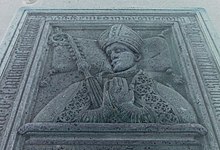Clement VIII (antipope)
Gil Sánchez Muñoz y Carbón (called Doncel , * 1369 in Teruel in Aragón , † December 28, 1446 in Mallorca ) was from 1423 until his resignation in 1429 as Clement VIII. Antipope in Peñíscola . It was an aftermath of the occidental schism that ended in 1417 with competing papal claims in Rome and Avignon .
The Avignon antipope Benedict XIII. 1417 had not accepted his deposition by the Council of Constance and the local election of the new, recognized Pope Martin V and withdrew to the castle fortress Peñíscola. After his death in 1423, Clement VIII was elected as his successor and his claim was recognized by the Crown of Aragon . After the unification between Rome and Aragon in 1429, Clement VIII renounced his title in favor of the recognition of Martin V - he was appointed Bishop of Mallorca by him and remained this until his death in 1447.
Life
Until the papal election
Gil Sánchez Muñoz was born in Teruel (Aragón) in 1369 as the son of Pedro II. Sanchez Muñoz y Liñán, Barón de Escriche, and Catalina Sanchez de Carbón.
He studied canon law and was then in the service of the Avignon Curia until 1396. As envoy of the antipope Benedict XIII. and the Archbishop of Valencia , Hugo de Lupia y Bagés , he tried to end the schism .
Election to the antipope

The Provost of Valencia was at the instigation of Alfonso V by three of the four remaining cardinals of the antipope Benedict XIII. elected as antipope to Pope Martin V after his death on June 10, 1423 in Peñíscola and achieved the recognition of the Aragonese and Sicilian King Alfonso V. One of the cardinals (allegedly) elected another antipope, Benedict XIV , parallel to Clement VIII , however, this choice was not announced until after the resignation of Clement VIII. Clement VIII was crowned only three years later on May 19, 1426.
abdication
After the conflict between Rome and Aragon had been resolved in 1429, Clement VIII called the cardinals of his obedience together on July 26, 1429 and declared his resignation from the papacy to them in the presence of the representative of Pope Martin V. After he had left the room, he came back - again in the official costume of a Provost of Valencia - and invited the assembled cardinals, the "very worthy Mr. Oddo di Colonna, whom the Romans call Martin V", to the new Pope choose. The cardinals then withdrew to the election and, as expected, announced the (renewed) election of Martin V as pope after a very short time.
This approach is often dismissed and ignored in historiography as a ridiculous formality. However, it should not be overlooked that due to the historically unclear legitimacy question of the various obediences, the re-election of Oddo di Colonna as Pope in any case represented additional legitimation. If the legitimacy of the obedience of Avignon ( Avignon Papacy ) were to be proven by any documents still to come out, all other elections, including those at the Council of Constance , would undoubtedly be considered null, so that only through this - and therefore by no means purely formal - Election act in Peñíscola an undoubtedly legitimate continuation of the papal succession could be ensured.
Last years
After retiring Gil Sánchez Muñoz by Pope Martin V was elected bishop of Mallorca appointed. His tomb is there in the Chapter House of Palma Cathedral .
literature
- Friedrich Wilhelm Bautz : Clemens VIII. In: Biographisch-Bibliographisches Kirchenlexikon (BBKL). Volume 1, Bautz, Hamm 1975. 2nd, unchanged edition Hamm 1990, ISBN 3-88309-013-1 , Sp. 1058.
Individual evidence
| predecessor | Office | successor |
|---|---|---|
| Luis de Pradés y de Árenós |
Bishop of Mallorca 1429–1447 |
Juan García |
| personal data | |
|---|---|
| SURNAME | Clement VIII |
| ALTERNATIVE NAMES | Sánchez Muñoz y Carbón, Gil |
| BRIEF DESCRIPTION | Antipope |
| DATE OF BIRTH | 1369 |
| PLACE OF BIRTH | Teruel |
| DATE OF DEATH | December 28, 1446 |
| Place of death | Mallorca |
